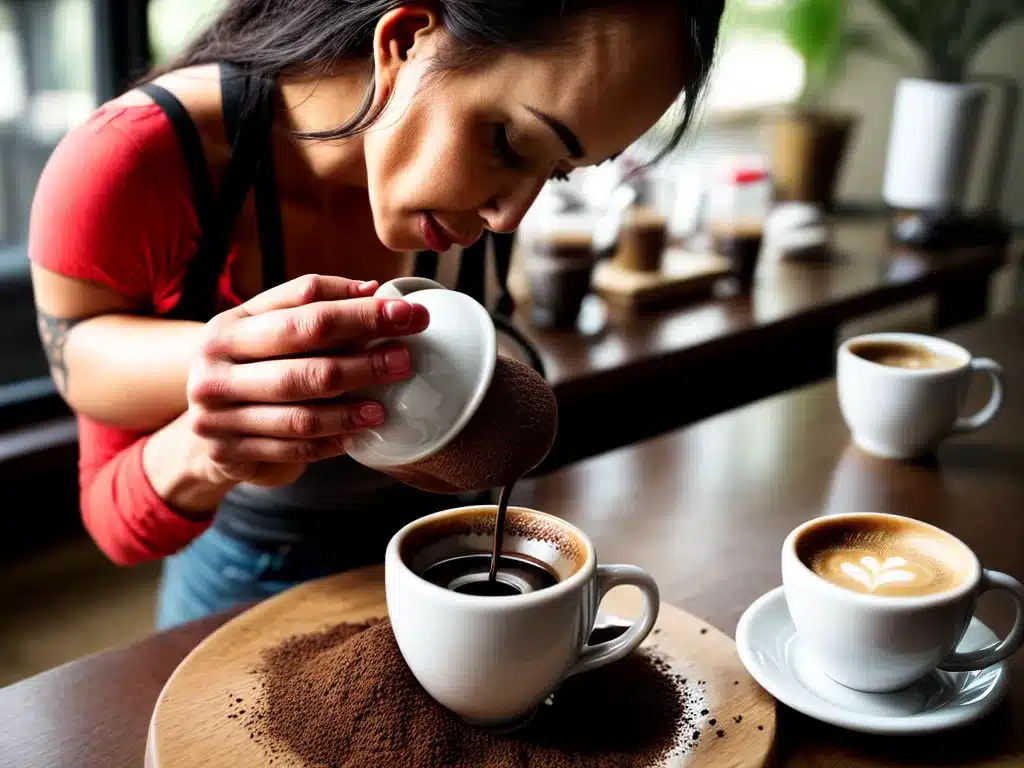 Coffee Cupping 101: An Intro to Tasting Coffee” />
Coffee Cupping 101: An Intro to Tasting Coffee” />
What is Coffee Cupping?
Coffee cupping is the process of evaluating and comparing coffees by tasting them. It involves carefully observing the aromas, flavors, textures, and aftertastes of brewed coffee samples. The goal is to assess the qualities and complexities of different coffees.
Cupping is a standard practice used by coffee producers, buyers, roasters, and baristas to detect flavors and defects in coffee beans and determine coffee quality. It allows the taster to identify key characteristics and flavors that give each coffee its unique profile. Mastering the art of cupping takes time and practice but is invaluable for understanding subtleties between coffees that influence pricing and consumer preference.
Why Cup Coffee?
Cupping coffee is the best way to fully evaluate the nuances of flavor, aroma, mouthfeel and aftertaste when sampling coffees side-by-side. It differs from typical coffee drinking methods in a few key ways:
- Cupping uses a standardized procedure for brewing and tasting each coffee sample. This removes variables and makes the coffees directly comparable.
- The coffee is tasted without added milk, sugar or flavorings. This allows the inherent qualities of the coffee itself to shine through.
- Cupping is done systematically, with evaluation forms to record your observations about each coffee’s characteristics. Tasting is done thoughtfully and analytically.
By cupping coffees, I can hone my tasting skills and vocabulary, identifying the subtle flavors that set coffees apart. It provides an invaluable education into the diversity and complexity of flavors found across different coffee varieties, processing methods, origins and roast levels.
The Coffee Cupping Process Step-By-Step
Cupping requires attention to detail and consistency at each stage. Here are the key steps:
1. Select the Coffees
First, gather a set of coffee samples to evaluate. Often 3-6 coffees are tasted in a single cupping session, marked with coded numbers for blind tasting. Select coffees that share similarities like origin, process or roast level to pinpoint their differences.
2. Roast the Samples
The coffees must be roasted uniformly for comparable cupping results. Sample roasts should be roasted medium to medium-light to best showcase origin characteristics. Use a sample roaster or production roaster to carefully control batch size, temperature and time to achieve the target roast level.
3. Grind the Coffee
Grind samples to a medium-fine consistency, similar to drip coffee. Use a consistent grinder just prior to cupping so the grinds are fresh. Measure precise weights, normally 8-10 grams of coffee per 6 oz. cup.
4. Smell the Dry Grounds
Before brewing, take a moment to smell the aromas of the dry grounds. Make notes on fragrance intensity, distinct aromas detected, differences perceived.
5. Brew Using Standardized Parameters
Brew the coffees using a cupping procedure to carefully control the extraction. The Specialty Coffee Association protocols involve:
- 202°F water poured onto grounds
- Steeping grounds for 4 minutes
- Breaking the crust with a spoon at 2 minutes
- Plunging grounds at 4 minutes
6. Sniff Aromas and Evaluate Fragrance
Once brewed, take deep sniffs of the aromas rising from each coffee cup. Note intensity, complexity, changes as the coffee cools. Detect specific aroma attributes (fruit, floral, sweetness, etc).
7. Slurp and Taste
Now, slurp each coffee loudly to spread the liquid over your palate. The vigorous slurping introduces air to release volatiles and analyze both taste and aroma simultaneously. Focus on the distinct flavors, acidity, sweetness, and mouthfeel of each coffee as you slurp.
8. Describe Flavors, Acidity and Body
Systematically make notes on the flavor profile using cupping forms. Describe individual flavor notes, the brightness/acidity, and weight/body of the coffee. Flavor wheels can guide your descriptor vocabulary.
9. Note Aftertaste and Finish
Pay close attention to the lingering aftertaste once the coffee is swallowed. Does any sweetness, acidity or flavor notes persist? How long does the finish linger on your palate?
10. Defect Analysis
Detect negative flavor defects like underdevelopment, over-fermentation or storage issues. Off-flavors like medicinal, mouldy or overripe notes can disqualify an otherwise promising coffee.
11. Cupping Forms and Scoring
Record your evaluations on cupping forms to systematically assess factors like aroma, flavor, acidity, body, uniformity and more. Coffees can be numerically scored or compared relative to one another.
Benefits of Learning to Cup Coffees
Here are some of the biggest benefits I’ve gained from honing my cupping skills:
-
Improved flavor recognition and vocabulary – Cupping develops my “sensory lexicon” for accurately describing complex flavors.
-
Ability to compare quality – Expert cupping lets me discern nuances that determine coffee quality and pricing.
-
Education on growing regions – It helps me appreciate the terroir and characteristics imparted by different coffee-growing origins.
-
Understanding processing methods – I can identify how methods like washing, honey processing and fermentation affect cup quality.
-
Roast development – Cupping shows me how different roast levels impact acidity, sweetness and flavor.
-
Blending skills – I can use cupping to experiment with blending ratios to create customized flavor profiles.
Overall, cupping has made me a much more mindful coffee taster and empowered me to better evaluate, discuss and appreciate all the diversity in specialty coffee. It’s a valuable skillset for coffee professionals and connoisseurs alike.



















